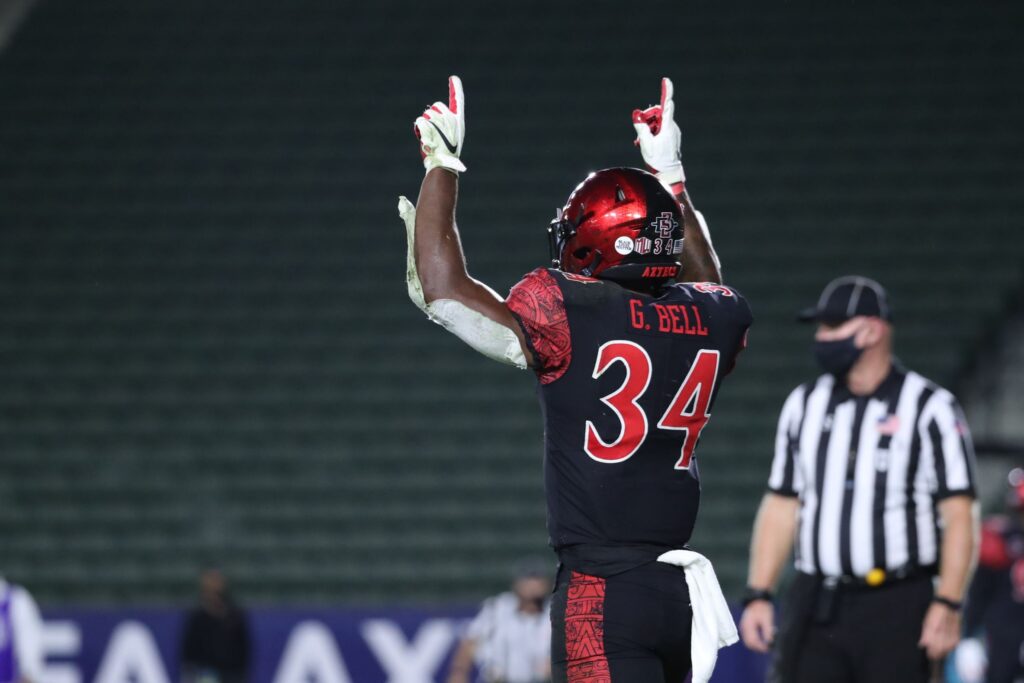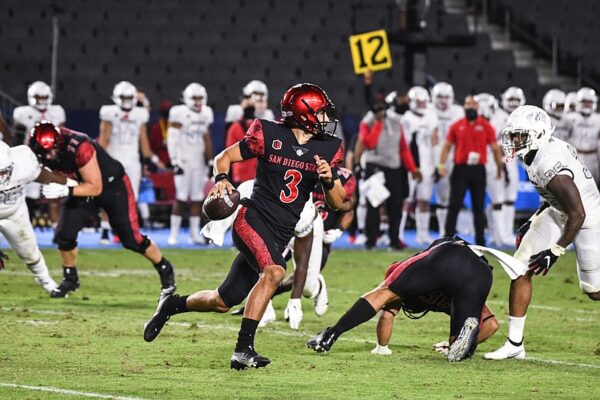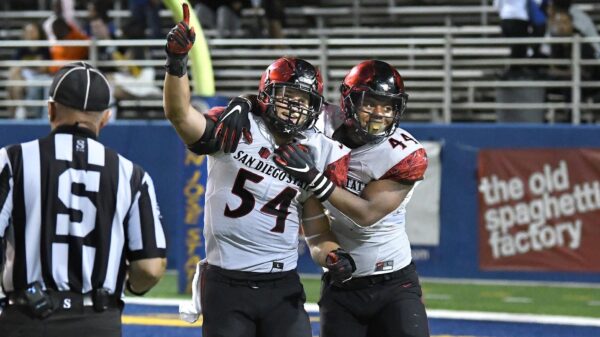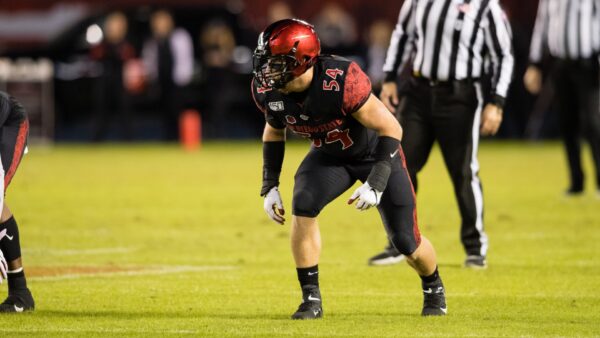The Aztecs at the halfway mark of the season

Credit: SDSU

San Diego State’s victory against Hawaii marked the halfway point of the regular season.
At 3-1, the Aztecs are in the hunt for their first Mountain West Championship since 2016 and the 22nd Conference Championship in program history.
What We Have Learned Through Half of the Season
- Different coordinator, same offense
2017 was the last time SDSU average more than 30 points per game. Rashaad Penny was a senior All-American on his way to becoming a first-round pick in the NFL draft. Behind Penny, SDSU’s running game was elite – averaging 252.5 yards per game. From 2018–2019, the Aztecs averaged only 20.9 points per game due mostly to a severe drop-off to 151.1 yards per game on the ground. Their passing game was below average in all three years, never averaging even 200 yards per game in any season. The main difference between the 2017 running game and the 2018-2019 versions was the lack of big plays. 2020 has been a microcosm of these three years.
In the three wins, the Aztecs resemble the 2017 version– averaging 35.3 points per game and a staggering 340 yards a game on the ground. In their one loss, they were eerily similar to the 2018-2019 teams, rushing for only 101 yards and scoring just 17 points. Greg Bell is the unquestioned star of the offense, and he has performed well in every game, but it was the lack of big plays against San Jose State that made all the difference. Against SJSU, Bell’s longest run was 13 yards.
- Hoke Rule No. 59: Unbelievable Effort Isn’t Unbelievable. It’s Expected.
Long time Aztec supporters will remember the marketing for the 2009 season built around “Hoke Rules.” Eleven years later, with a few twists and turns along the way, it is encouraging to see SDSU’s first-year head coach is still able to inspire his players to give “unbelievable effort.” This team is simply a joy to watch because they play the game with such enthusiasm and effort.
On defense, eleven hats race to the football on each play. Each yard is contested, and they are only satisfied with perfection. Older players mentor younger players and are their biggest fans. Players rotate in and out, and each game, a new contributor, impacts the game in a meaningful way.
The four best players on offense are possibly the top four running backs on the depth chart. What could be cause for jealousy and strife has proven to be a strength as Jeff Horton’s group genuinely celebrates each other’s success. For a good reason, fans have been more than frustrated with Carson Baker and the passing game, but there has not been one word or one tweet spoken negatively from players on the team.
When Hoke was first hired in 2009, he said, “We want to recruit kids who have high character and have integrity, guys who understand the value of a degree, and guys who have a passion to play.” These are exactly the kids in this program. The players are tremendous ambassadors of their families, the coaches, the university, the city, and most importantly, themselves.

- The West is the Best
Since the Mountain West Conference split into two divisions in 2013, the general consensus was the Mountain Division was superior to the West Division. This year the tables have turned. The West has a combined 16 – 8 conference record, and the Mountain currently sits at 5 – 13. At the top of the standings, five of the top six teams play in the same division as the Aztecs.
The Mountain West suspended its division format for the 2020 season, but it kept the scheduling format as if the divisions still existed. What that means is an easier road to the conference championship for Boise State. San Diego State is in the midst of four consecutive games against teams with winning records. Meanwhile, Boise State is guaranteed to play only one conference game all season against a team with a winning record. That team is San Jose State from the West Division.
Questions from the Second Quarter of the Season
In the first installment of this series, questions were posed to focus on during the second quarter of the season. Below the questions are revisited to see how the team answered them.
- Has the early domination by the Aztecs been fool’s gold?
The Aztecs have three blowout wins and one loss where they sabotaged their chance of winning with two fourth-quarter turnovers. In fact, SDSU is one of three teams nationally to win 75% of their games by 24 points or more. This team has more talent, more size, and more collective speed than any since the 2016 Mountain West Championship team. With a little help, this team is every bit the championship contender.
- What is the identity of Jeff Hecklinski’s Offense?
For better or for worse, Hecklinski is committed to having a balanced offensive attack. Each game, he has opened passing the ball as much or more than running it. This past week, the Aztecs attempted only 13 pass plays, but seven of them came in the first quarter. It is certainly expected that a new offensive coordinator needs more time to install his system, and so far, that has meant equal treatment of the passing and running game. The passing game’s most successful plays have come with play-action, but even this success has not convinced Hecklinski to adopt a run-first approach. Only time will tell if his designs will give the Aztecs their first dual-threat offense since Quinn Kaehler (3,007 yards passing) and Adam Muema (1244 yards rushing) shared a backfield in 2013.

- How good can this defense be?
The sky continues to be the limit for this defense. SDSU is the only team in the country to hold its last five opponents under 300 yards total offense. You would have to go back to the 2018 season to find a team that had more than 450 yards against them. They have forced three and outs 52% of the time this season. Opposing offenses are averaging only 3.15 points a quarter in the past 46 quarters. The contributions have come from all levels of the field, from starters and non-starters alike. The linebackers have been their least dominant position group, but the defense’s most dominant player statistically, Caden McDonald, is a linebacker. As we turn our attention to the third quarter of the season, we begin to wonder where the 2020 defense ranks among all time great defenses in school history.
Questions for the third quarter of the Season
- Are the Aztecs contenders or pretenders?
The race for the two spots in the conference championship will take shape during the third quarter of the season. There are currently six teams with a .500 or better record in the conference. These teams play each other over the next two weeks. Beginning Saturday, SDSU plays at undefeated Nevada and at Fresno State. Nevada follows its game with SDSU with a road game against Hawaii. San Jose State plays at Fresno State and at Boise State. Boise State plays at Hawaii this week. The team(s) that emerges from this gauntlet with a pair of wins will put itself in a terrific position down the stretch.
- Who is the starting Quarterback?
Carson Baker came into the season as the clear starter. After his performance in the first half of the season, it is difficult to believe he will continue to lead the team in the second. Coach Hoke has been coy about naming Lucas Johnson the starter this week against Nevada, but Baker’s poor play has clearly forced his hand. Baker’s composure was his biggest strength through his first three starts, but his lack of poise in his past four quarters should elevate Johnson to the top spot. What exactly is SDSU getting in Johnson? He is clearly a terrific athlete when running the football, but can he throw the football well enough to attain the balance his offensive coordinator desires? Baker won the starting job over Johnson for a reason. Will opposing defenses find and exploit that reason?
- Will the team fix its Special Teams?
In order for the Aztecs to be a complete team capable of winning a Mountain West Title, their special team’s group needs to improve. They have lost three fumbles in four games, missed two field goals, and have a mediocre kick return average of 19.88 yards per kick return – good for 64th in the country. SDSU’s next two games are on the road and expected to be close. The special teams could be the difference between winning and losing.
My earliest sport’s memory involve tailgating at the Murph, running down the circular exit ramps, and seeing the Padres, Chargers and Aztecs play. As a second generation Aztec, I am passionate about all things SDSU. Other interests include raising my four children, being a great husband and teaching high school.